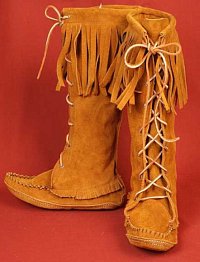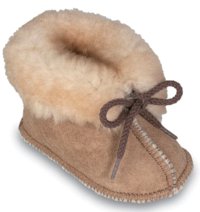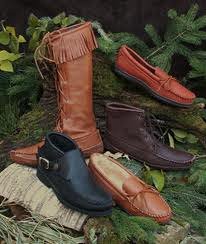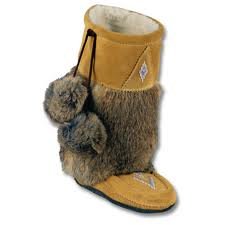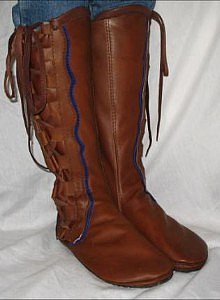|
Handmade MoccasinsWhat are Handmade Moccasins? "Moccasin" comes from the word, “maskisina”, a word from the Algonquian tribe meaning shoes. This was America’s first footwear. Moccasins were handmade from the skin of buffalo, deer, or elk. These skins were sometimes dressed in a manner that resembled the European way (hair removed) or with the hair remaining on them.
History of Handmade Moccasins: Once upon a time, a great Chief of the Plains had very tender feet. To make matters worse, the braves of the tribe were making arrowheads and left stone chips laying on the ground. As the story goes, the great Chief stepped on them and cut his feet. That night the Medicine Man was given an impossible task by the angry Chief, “Cover the whole earth with mats so thick that my feet will not get cut or hurt”. So, to make a long story short the Medicine Man woke up the next morning with a thought. Instead of covering the Earth, maybe cover his feet”. “Maskisina” was born. (There’s a lesson in there somewhere) All the tribes had a word for shoes in their own language, but "moccasin" is the word that Europeans chose to call them, and it is now the common name. There are at least 5 other ways to spell “moccasin”. Can you name them? (mocasin, mocassin, moccassin, mocassions,or mocussin, depending on the language)
How to make Handmade Moccasins: Here's a short video on making your own simple handmade moccasins. It takes time and patients. Just like anything else, you won’t be an expert the first time. Don’t forget, when tracing your foot on the paper, keep the pencil vertical. Don’t angle the pencil under your arch or you will end up with handmade moccasins that are too tight. Start with your new moccasins Inside Out. Leave about ¼” extra around the sole for stitches.
Tools and Materials:
So, now you need some leather. First take a look at various leather samples to get an idea of what you want. Cowhide works fine and is durable but deerskin, elk skin, and buffalo will put you over the top in the looks department. If you’re making mukluks (the Inuit version of moccasins), caribou is the only way to go.
I have a pair of Alaskan Mukluks and they are unbelievably warm. And they are caribou. Use heavier leather for the sole for better wear. Double soles are also a good idea. For a double sole you can use leather or carpet backing. Carpet backing is very pliable and has various thicknesses. Moccasin makers are also using epoxy and shredded tires for the soles. This method makes sense to me because it reduces the need for repairing worn out soles. All you have to do is coat the sole with epoxy and sprinkle on more shredded tire, let it set and your fixed up for another couple hundred miles. One of the Artists we are looking at actually has a kit with everything you need for a class “A” repair. If you are planning on wearing your mocs full time you might want to look into a hard sole. This would give you a long wearing shoe and the look of a moccasin. For this type I would suggest you go to a real moccasin maker as this is a little more difficult and requires some experience to pull off. To acquire the leather a local furrier will work. A taxidermist will also often have leather and fur around for sale. For a great selection we think the selections can be found at Tandy Leather (American) and FurCanada (Canadian). They have a huge selection and will get you exactly what you need. This would be for a more high-end moccasin.
If you are buying moccasins: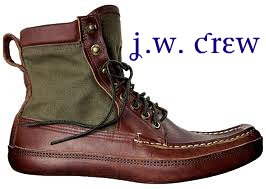
Care of Handmade Moccasins:They love "grease". But not just any grease. A 50/50 split between tallow and bees wax, makes for a good grease. The more beeswax, up to a point, the longer it lasts. Grease them more often in wet weather. And every time you dry them out (slowly, low heat!), give them a greasing. Another option is to purchase and use some modern leather prep. Then you won’t have to worry about it. Brothers-Handmade is looking into various Leather craftsmen that work in this Art. And yes, after looking at so many handmade moccasins and mukluks for this article it is safe to say this is an Art. Back in the day I’ll bet the most incredible mocs and muks were owned by the women who made them for the tribe. As a matter of fact, I know that’s who had the most beautiful foot ware!!! |
Appreciate when you ...
16 Original Paintings by Steven Purdon
On Sale Now
15% Discount until
Tuesday, October 23, 2012.
" My favorite work is the Dejenne men. This represented a turning point for me and has some spiritual meaning as well... it creates emotion for me as I imagine what the men are looking at with such concern."
-Steven Purdon








